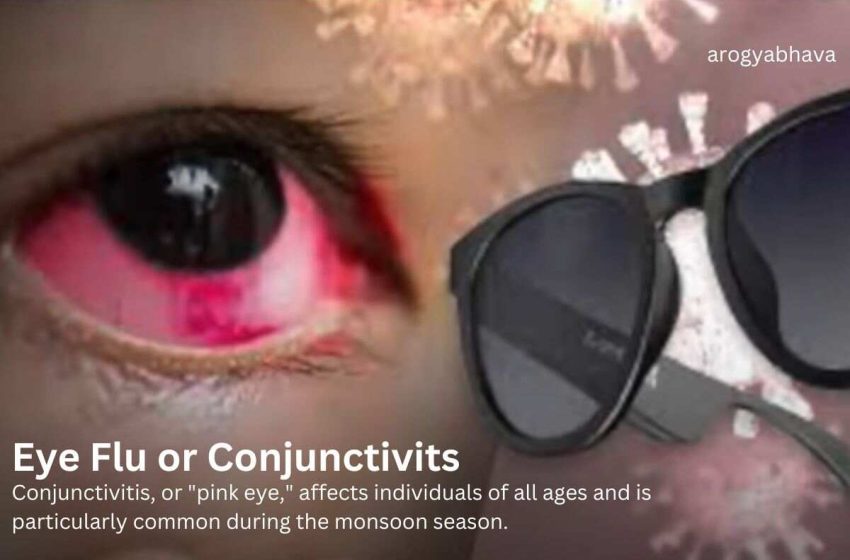Eye Flu: An In-Depth Guide to Prevent Conjunctivitis

Healthy eyes are a crucial component of overall good health. Knowledge about common eye conditions like eye flu, also known as conjunctivitis, is essential to maintaining good vision. Conjunctivitis, or “pink eye,” affects individuals of all ages and is particularly common during the monsoon season.
History of Conjunctivitis
The term conjunctivitis is derived from the Latin word “conjunctiva,” which refers to the thin, transparent membrane covering the eye’s surface and lining the inner eyelids. Historical records of conjunctivitis date back to ancient Egypt and India. The Roman physician Galen first described a condition resembling pink eye in the first century, and the term “conjunctivitis” was later introduced in the 17th century by English physician Thomas Willis.
Causes and Symptoms of Eye Flu
Eye flu can be caused by viruses, bacteria, allergens, or irritants that inflame the conjunctiva. Viral conjunctivitis, often linked to upper respiratory infections, is highly contagious. Bacterial conjunctivitis typically presents with a discharge and can result from various bacterial infections. Allergic conjunctivitis is triggered by allergens like dust mites or pet dander .
Common symptoms of eye flu include:
- Redness in the eyes
- Swollen eyelids
- Itching in the eyes
- Continuous tearing
- Thick yellow discharge
- Sensitivity to light
- Fever, headache, and sore throat (in some cases)
Vision is usually not affected by eye flu.
Diagnosis and Treatment of Eye Flu
Eye flu is often diagnosed based on symptoms. In some cases, doctors may take a sample of eye secretions to identify the causing bacteria or virus .
Tips and Remedies to Avoid Eye Flu
For viral conjunctivitis, there is no specific treatment. Recommended care includes rest, cold compresses, and artificial tears to keep the eyes moist. Bacterial conjunctivitis can be treated with antibiotics in the form of eye drops or ointments .
Hygiene and Care Tips To Prevent Conjunctivitis
You can follow below hygiene and care tips to prevent eye flu.
1. Maintain Proper Hygiene
Wash hands frequently and avoid touching or rubbing the eyes. Use a clean, moist washcloth to remove eye secretions gently. Change eye makeup and contact lenses regularly.
2. Cold Compresses
Applying a cold compress can relieve burning and stinging, promoting healing. Use a clean cloth dipped in cold water (10-12 degrees) and apply it to closed eyelids for 5-10 minutes, refreshing the compress regularly.
3. Artificial Tears
Lubricating eye drops help soothe dryness and irritation. Ensure they are preservative-free.
4. Medications
In some cases, antiviral or antibiotic eye drops or ointments may be prescribed to manage symptoms and prevent complications.
5. Allergy Medications
For allergic conjunctivitis, allergy medications or eye drops can relieve itching and inflammation.
Precautions in Eye Flu and Its Prevention
Certain precautions are required during the rainy season to prevent eye flu. Below are some precautions, which you can follow.
Follow Hygiene Rules
Wash your hands frequently, especially after touching surfaces in public places, and avoid touching or rubbing your eyes.
Do Not Share Personal Items
Avoid sharing towels, tissues, or eye makeup with others.
Disinfect Lenses
Properly disinfect and clean contact lenses as per guidelines. Avoid wearing contact lenses during infection.
Prevention of Allergies
Identify and avoid allergens if prone to allergic conjunctivitis. Keep windows closed during high pollen seasons.
Eye Protection
Use protective eyewear to shield eyes from irritants and allergens.
Healthy Habits
- Expose your eyes to sunlight in the morning at sunrise for at least two minutes.
- Practice Jal Neti daily if familiar with naturopathy.
- Eat a balanced diet rich in fresh vegetables and fruits and avoid fried and oily foods during an eye infection.
Conclusion
Eye flu, or conjunctivitis, is a common eye ailment that can disrupt daily life but is manageable with proper care and precautions. By understanding its history, causes, symptoms, treatment, and prevention methods, you can protect your eye health and that of your loved ones. Timely prevention and maintaining good eye hygiene are crucial in preventing the spread of eye flu and ensuring that your eyes remain healthy and vibrant. If you suspect you have eye flu, consult a doctor for diagnosis and appropriate treatment.
Also Read: How To Protect Your Eyes While Swimming